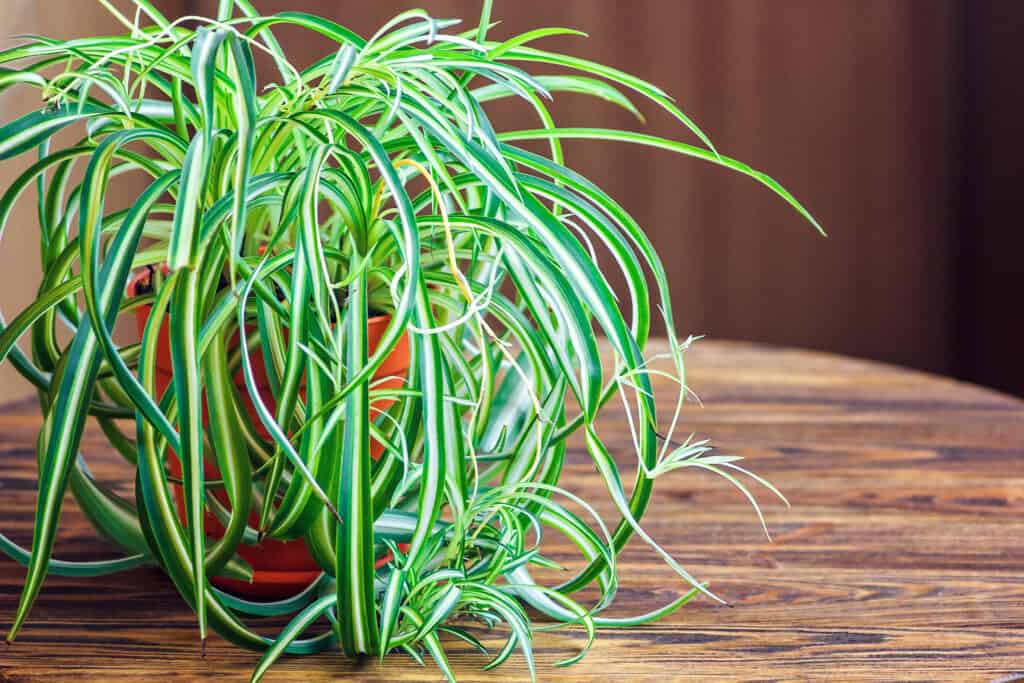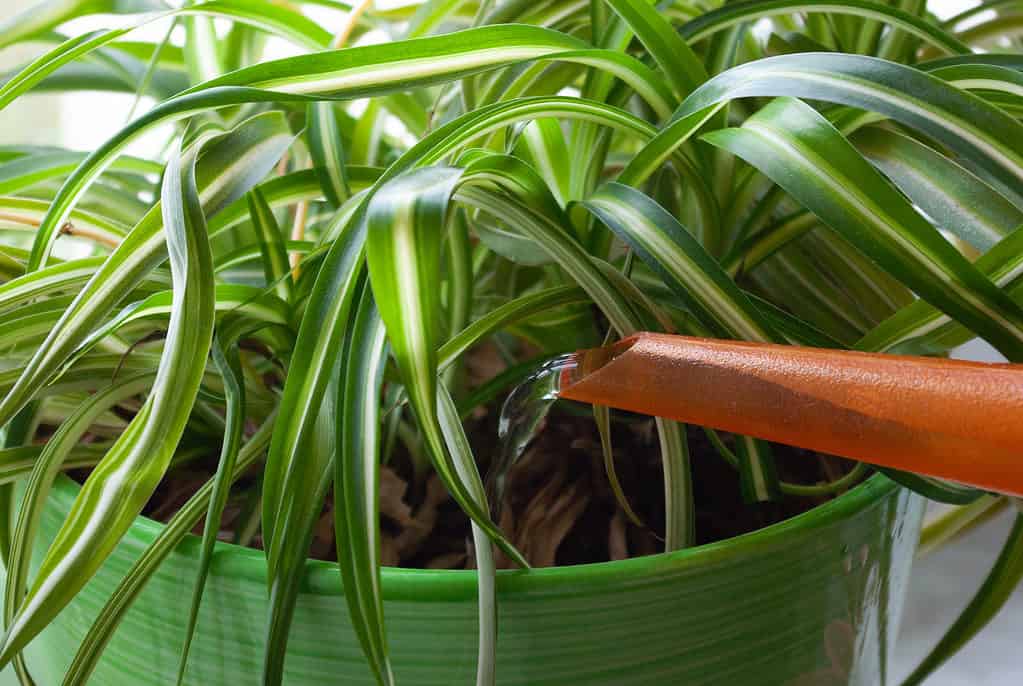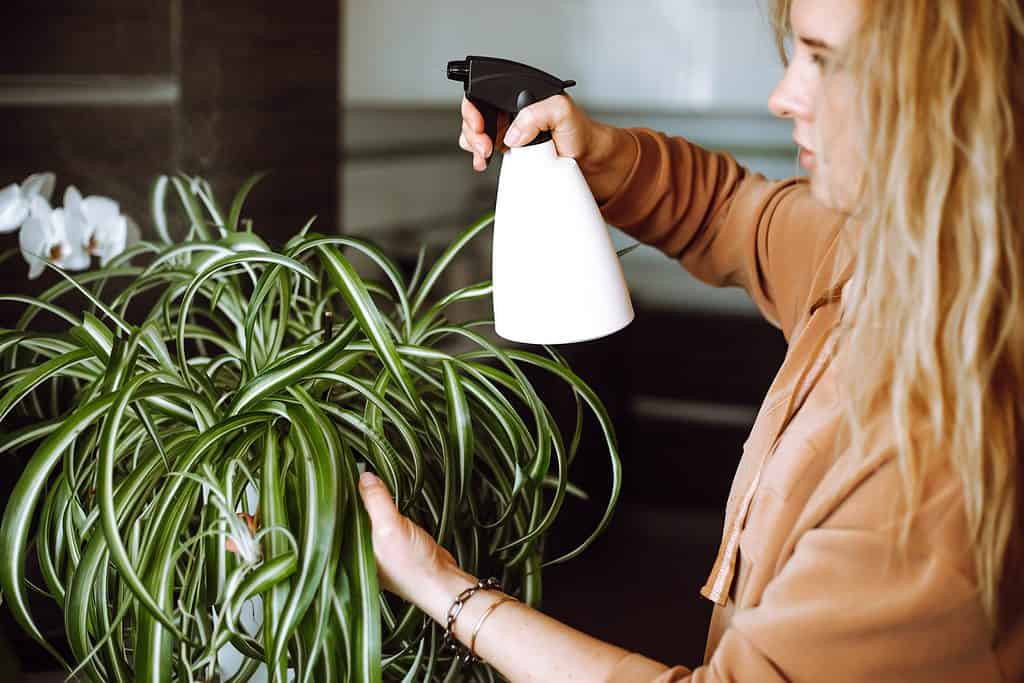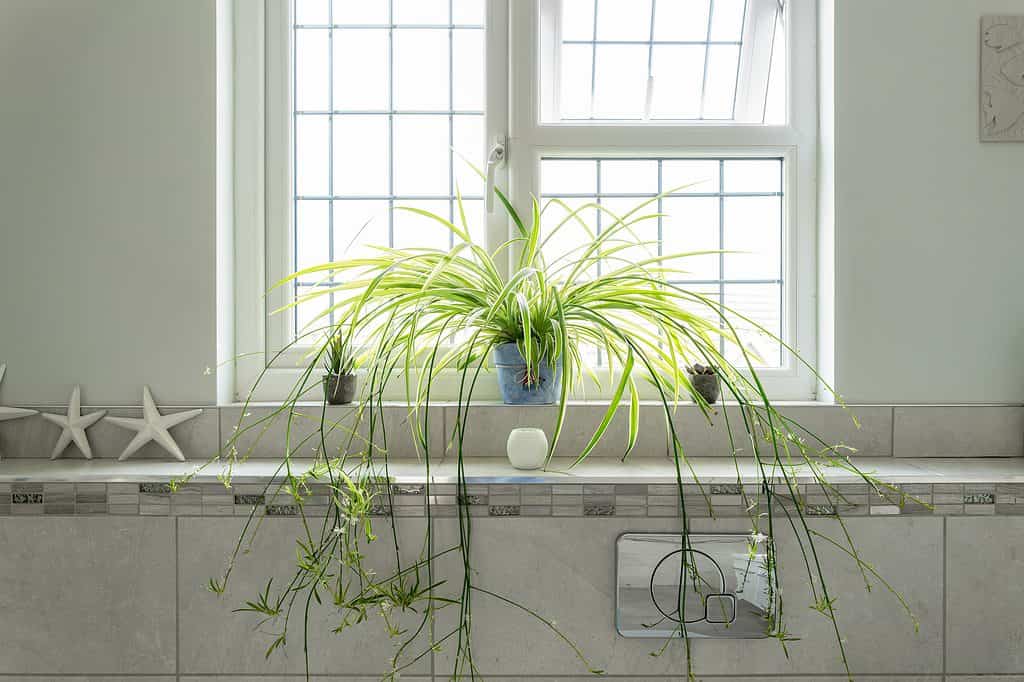The spider plant (classified as Chlorophytum comosum) is one of the more common choices for indoor plants that, with appropriate care, may thrive for many years. They are particularly popular for their beautiful and unique foliage that boasts long, spindly leaves that can come in a range of shades of green and different patterns. Despite being a low-maintenance plant, cultivating spider plants can present a few common issues. Browning tips, curling leaves, root rot, leaf blight, dropping leaves, and lack of growth are a few frequent issues that arise when growing plants.
In this guide, we’ll explore everything you need to know about spider plant leaves, including some common problems plant parents may encounter and how to fix them.
What is a Spider Plant?
Chlorophytum comosum, often known as the spider plant or spider ivy, gets its common name from the plantlets that hang from its stems like spiders from silk stands. This African native plant has been a favorite since the Victorian era when it was occasionally referred to as the ribbon plant. USDA hardiness zones 9 through 11 are suitable for growing this unique plant. However, it is typically used as a low-maintenance houseplant, making it considerably simpler for even inexperienced plant owners to take care of spider plants.
The rosette of spider plant leaves, which are frequently variegated, thin, and wrinkled, rises from the middle of the container and cascades down on all sides. The biggest cultivars have a maximum height and breadth of two feet. The size of the leaves, however, ranges from six inches for dwarf variations to sixteen inches for full-size variations. Each plant should have erect stems with racemes of white, six-pointed, half-inch blooms when fully grown. Eventually, their stems slant to dangle the aforementioned plantlets, which look quite lovely in hanging baskets.
Clearly, the foliage of the spider plant is the star of the show. But what can a plant owner do if their spider plant’s beautiful leaves begin to suffer from problems like brown tips, black leaves, or drooping foliage?

With the right care, spider plant leaves (pictured) can grow quite long and healthy.
©Bozhena Melnyk/Shutterstock.com
Common Spider Plant Leaf Problems
The spider plant is very leafy, so one will want the plant’s foliage to look its best. The following leaf problems are quite common, and each of these problems has simple solutions.
Brown Leaves
When the leaves of your spider plant become black or dark brown, this almost always indicates that it has been overwatered and is suffering from root rot.
Try these two strategies to help your plant survive: First, make sure the soil you use is able to drain quickly. Perlite, sand, and other elements that permit water to pass through the soil make up suitable fast-draining soil. Second, be careful not to water your spider plant so frequently that the roots become submerged in water.
Before watering again, remove the damaged leaves and let the soil dry out for a bit. It can be a good idea to familiarize yourself with the fundamentals of watering indoor plants and create a routine for regular watering to avoid overdoing it in the future.
Black Leaves
Spider plants are quite beloved for their attractive foliage. Since they are from southern Africa, they cannot withstand cold conditions. Although they are mostly cultivated indoors, they are occasionally grown outside in warm climates. As long as there are no freezes, one can usually successfully grow a spider plant outside. If your outdoor or indoor spider plant develops black tips, commonly known as necrotic leaf tips, the culprit usually comes down to cold temperatures, water, and humidity.
Spider plants thrive between 70 and 90 degrees F. They can survive temperatures as low as 35 degrees F but may develop black leaves if subjected to further cold temperatures. Just as well, spider plants need a high enough humidity level to prevent leaf tip burn and blackening of the leaves, but they shouldn’t be standing in a saucer of water. The soil needs to somewhat dry out in between irrigations. However, spider plants shouldn’t be allowed to dry out fully. The leaves will begin to get discolored if there is not enough moisture, starting at the tips.
Just as well, your spider plant could be becoming black because it needs to be repotted or because it is too close to a furnace or other artificial source of heat. Plants that are rootbound are unable to absorb moisture adequately. However, merely shifting the plant to a bigger container frequently improves moisture absorption. Refrain from planting your spider plant too close to a furnace or air conditioner; move it somewhere away from those areas.
If none of the aforementioned probable fixes work, your spider plant’s leaves may become black due to too much fertilizer or water containing too much fluoride. If so, you should only use distilled water for your plant. Change your fertilizer, or fertilize your spider plant less often.
Brown Leaf Tips
The tips of the leaves of indoor spider plants frequently become brown if it is not being cared for properly. This often indicates one of three things: your spider plant needs more humidity, the water it receives contains a lot of chlorine, or it receives too much direct sunlight.
If your home’s air is very dry, spray your plants frequently or place a humidifier nearby. Brown tips may also result from the tap water’s high chlorine content. Use distilled or filtered water instead. Additionally, you may water your plant with collected rainwater or tap water that has been left out for 24 hours so that the chemicals in the water can evaporate. Does your hanging plant receive a lot of direct sunlight? If so, sunburn may very possibly be the cause of the brown patches on the tips of its leaves. Place your plant somewhere that receives less direct sunlight.
If you choose, you can gently trim the brown leaf tips off with a pair of sharp scissors. Brown leaf tips can only be prevented; they cannot be reversed. They can be pruned to help your plant look better.

A potted spider plant (pictured) may suffer from drooping leaves if it is not watered properly.
©iStock.com/Simplylesia
Drooping or Wilting Leaves
If your spider plant seems weak and drooping, the main cause is probably a hydration problem. The plant may wilt if it is not given enough water or receives too much sun. Your spider plant may, however, become limp or droopy in extremely rare circumstances if it receives too much water.
If your spider plant is wilting, try a few different solutions to get it to perk up. Start by giving your spider plant a strong supply of water right away, either from the faucet or by watering from the bottom. Additionally, you may give your plant a good 15 minutes of water soaking. If you think your plant is wilting due to overwatering, wait until the soil is completely dry before watering again.
You could also try putting the plant in indirect sunlight. A fantastic example of a location where spider plants flourish well is an east-facing window. A southwest-facing spot is also a good idea to gain shade during the day. Take the plant as soon as possible to a cooler spot if it begins to wilt from too much sun exposure.
Yellowish Leaves
The most common causes of yellow leaves are overwatering or underwatering. Remove the damaged leaves of your spider plant via pruning, then change your watering schedule going forward. To assist you in determining when to water, you may purchase a moisture meter. These devices will automatically detect how damp your soil is for you. Generally, your plant is likely underwatered if its leaves feel dry and crunchy. If your plant is overwatered, its soil will be soggy, and its leaves will seem rubbery.
Because of inadequate lighting, your spider plant’s leaves may also become pale yellow. When exposed to low light for an extended period of time, variegated spider plants may even completely lose their white stripes and turn solid green. Moving your plant to a location where it receives plenty of bright, indirect light is the simple solution. An additional option is a grow lamp. These used to be quite expensive and cumbersomely huge. Nowadays, small and reasonably priced plant lights are widely available and easy to find.
Curling Leaves
Curled leaves on your spider plant can be caused by various issues, which can be quite difficult to diagnose. Finding the cause is sometimes difficult. Underwatering, overwatering, problems with water quality, acidic soil, or root rot can all result in curled leaves.
Check your plant’s soil. If it is dry, it is likely underwatered. If it is soggy, it is likely overwatered. Overwatering can also cause root rot. If your soil looks good, water purity is the next potential cause. Start using distilled or purified water to mist and water your plant. If that doesn’t work, get a plant soil pH test kit to see your soil’s pH. Slightly alkaline soils are best for spider plants, anywhere from 6.2 to 6.5. If your soil is too high or low pH-wise, you might need to repot your plant with better soil.
Diseased Leaves
Another significant factor in leaf loss in spider plants is disease. The first signs of bacterial leaf blight are mild lesions on the leaf tips that eventually turn dark. Bacterial leaf spots and tip burns are characterized by browning edges and yellowing in the leaf border if it is being kept in hot and humid areas with poor ventilation.
These diseases can be controlled by improving circulation, refraining from overhead watering, and removing damaged leaves. In order to endure the disease’s stress and grow fresh, healthy foliage, spider plants require exceptional care and attention until it has recovered. Unfortunately, the plant should be disposed of if the illness has advanced to the point where it is harming the stems.

Misting your spider plant (pictured) with a spray bottle is a great way to keep pests away.
©tativophotos/Shutterstock.com
Leaf-Eating Pests
Although spider plants are resistant to most insect infestations, they are sometimes vulnerable to pests. Depending on where you live, your spider plant’s leaves and other parts can be eaten by aphids, mealybugs, Whitefield mites, and spider mites. Luckily, you can prevent this by occasionally misting your plant’s leaves with a water mister. You might also have to use pesticides to get rid of them if the issue gets worse. Consider using organic dish soap diluted with vinegar as an alternative to harsh chemical pesticides.
We’ve explored quite a few different common problems that your spider plant may experience. Luckily, all of the common problems associated with growing a spider plant are fairly easy to diagnose and fix. This beautiful, beloved houseplant can thrive for many years to come with its beautiful foliage as long as you give it the necessary care it needs.
Can I Cut all the Leaves off my Spider Plant?

A very large spider plant can grow babies, known as spiderettes, that can be used to grow new plants.
©Nick Beer/Shutterstock.com
Spider plants, for the most part, do not need to be pruned and can be left on their own to grow. They tend to grow rather large and will even sprout what look like babies, which are actually called spiderettes or pups. These pups can be removed and replanted, which will in turn create a new spider plant. However, if your plant is getting too large, you may trim back the healthy leaves from the base of the foliage.
In addition, while the leaves of spider plants are not toxic, they may contain chemical compounds that when ingested by felines can produce mild hallucinogenic effects. In humans, these plants may have health-promoting properties, but they can also have mild adverse effects that can result in upset stomachs and diarrhea.
Do you want to learn even more about the incredible and resilient spider plant? Take a look at our complete guide to spider plants here!
The photo featured at the top of this post is © iStock.com/niuniu
Sources
- NCSU Staff, Available here: https://plants.ces.ncsu.edu/plants/chlorophytum-comosum/
- Susan Mahr, Available here: https://hort.extension.wisc.edu/articles/spider-plant-chlorophytum-comosum/
- Bonnie L. Grant, Available here: https://www.gardeningknowhow.com/houseplants/spider-plant/black-tips-on-spider-plant.htm
FAQs (Frequently Asked Questions)
What type of leaves do spider plants have?
Spider plants have long, narrow, grass-like leaves.
Should I prune my spider plant of its brown leaf tips?
In most cases, yes. You should trim the brown bits off of your spider plant leaves, as the damage has already been done. Use clean and sharp scissors.
Should I remove babies from my spider plant?
Spiderettes should be removed often to ensure your plant is not expelling too much energy. These baby spider plants can be propagated into new plants.
Thank you for reading! Have some feedback for us? Contact the AZ Animals editorial team.







